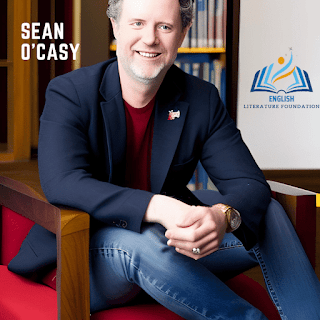Juno and the Paycock by Sean O'Casy: A Detailed Summary
Introduction
Juno and the Paycock is a play written by Sean O'Casy, first
performed in 1924. It is set in Dublin during the Irish Civil War and focuses
on the Boyle family, particularly Juno and her husband, "Captain"
Jack Boyle. The play is known for its combination of tragic and comic elements,
as well as its commentary on the effects of poverty, war, and politics on
everyday people.
Brief Background on the Play
Sean O'Casy was a prominent figure in the Irish literary
scene during the early 20th century, and Juno and the Paycock is one of his
most famous works. The play was initially met with controversy due to its
portrayal of the Irish working class and its use of Dublin slang, but it has
since become a staple of modern Irish theatre.
Overview of the Plot
The play begins with Juno Boyle, a hard-working and
practical woman, trying to keep her family afloat amidst the chaos of the Irish
Civil War. Her husband, Jack, is a lazy and drunken former sailor who spends
most of his time at the local pub with his friend Joxer Daly. Their son Johnny
is a former IRA member who has been left crippled by a bomb explosion.
Despite their struggles, the Boyle family remains hopeful
that they will receive an inheritance from a distant relative. When news of the
inheritance arrives, their fortunes seem to turn around, but they soon discover
that the money is not as secure as they thought. As the play progresses,
tensions rise between family members, secrets are revealed, and tragedy
strikes.
Significance of the Play
Juno and the Paycock is significant for its portrayal of
working-class Irish life during a tumultuous period in Irish history. The play
highlights the struggles of everyday people during times of war and political
upheaval, as well as the devastating effects of poverty and social inequality.
It is also notable for its use of language, including Dublin slang and characters
who speak in a mixture of English and Irish.
Overall, Juno and the Paycock remains a timeless and
powerful commentary on the human condition, and it continues to be celebrated
as a masterpiece of modern Irish drama.
II. Characters
Juno and the Paycock features a range of complex and
memorable characters. Here are the main characters and a brief description of
each:
A. Captain Jack Boyle
Captain Jack Boyle is the patriarch of the Boyle family. He
is a former sailor and a heavy drinker who spends most of his time at the local
pub with his friend Joxer Daly. Jack is often portrayed as lazy and selfish,
and he is not always faithful to his wife Juno. However, he also has moments of
charm and humour, and he genuinely cares for his family in his own way.
B. Juno Boyle
Juno Boyle is the strong-willed matriarch of the Boyle
family. She is a hard-working and practical woman who does her best to keep her
family together during times of hardship. Juno is often frustrated by her
husband Jack's behaviour, but she is fiercely loyal to her family and will do
whatever it takes to protect them. She is also known for her sharp wit and no-nonsense
attitude.
C. Mary Boyle
Mary Boyle is the daughter of Jack and Juno Boyle. She is a
young woman who is desperate to escape the poverty and hardship of her family's
life. Mary is intelligent and independent, and she dreams of a better future
for herself. She becomes engaged to her boyfriend Charles Bentham, a
schoolteacher, but their relationship is tested when Mary discovers a family
secret.
D. Johnny Boyle
Johnny Boyle is the son of Jack and Juno Boyle. He is a
former IRA member who has been left crippled by a bomb explosion. Johnny is
haunted by his past actions and struggles to come to terms with his disability.
He is also deeply conflicted about the role of the IRA in the ongoing civil
war, and his loyalty to his former comrades is tested throughout the play.
E. Joxer Daly
Joxer Daly is Jack Boyle's friend and drinking companion. He
is often portrayed as a sycophantic and opportunistic character who is willing
to do whatever it takes to get ahead. Joxer is a frequent source of comic
relief in the play, but he also plays a role in some of the more dramatic
events. His relationship with Jack is complex, and it is often suggested that
Joxer is taking advantage of Jack's weaknesses for his own benefit.
These characters and their relationships form the backbone
of Juno and the Paycock, and their interactions drive the plot forward.
O'Casy's skillful portrayal of these complex and flawed characters is a key
reason why the play remains so compelling to this day.
III. Themes
Juno and the Paycock explores a range of complex themes that
are still relevant today. Here are the main themes and a brief description of
each:
A. Poverty and Struggle
One of the central themes of the play is poverty and
struggle. The Boyle family lives in a tenement flat in Dublin, and they
struggle to make ends meet. They are constantly facing the threat of eviction
and have to rely on the goodwill of others to survive. The play highlights the
harsh realities of life for the working-class in early twentieth-century
Dublin, and the ways in which poverty can impact people's lives.
B. Gender Roles and Expectations
Another important theme of the play is gender roles and
expectations. Juno Boyle is portrayed as a strong and independent woman who is
forced to take charge of her family due to her husband's drinking and laziness.
Mary Boyle, meanwhile, is struggling to break free from the traditional gender
roles that have been imposed on her. The play highlights the ways in which
societal expectations can limit people's opportunities and choices.
C. Family Dynamics and Relationships
Family dynamics and relationships are at the heart of Juno
and the Paycock. The Boyle family is a complex and often dysfunctional unit,
with each member struggling to find their place within it. The play explores
the relationships between parents and children, husbands and wives, and
siblings, and highlights the ways in which these relationships can be both
supportive and destructive.
D. Nationalism and Patriotism
Nationalism and patriotism are also important themes in the
play. The characters are all caught up in the political turmoil of early
twentieth-century Ireland, with the threat of civil war looming in the
background. The play highlights the ways in which political ideologies can
impact personal relationships and how national identity can be both a source of
pride and a source of conflict.
Overall, Juno and the Paycock is a powerful exploration of
the struggles and complexities of everyday life. The play's themes are still
relevant today, and its characters continue to resonate with audiences around the
world.
IV. Symbolism and Imagery
Juno and the Paycock is rich in symbolism and imagery, which
adds depth and complexity to the play. Here are the main symbols and images and
a brief description of each:
A. The Paycock
The paycock, or peacock, is a recurring symbol in the play.
It represents Captain Jack Boyle's desire to be seen as important and
respectable, despite his lack of money and success. He sees himself as a noble
bird, proud and dignified, but in reality, he is a cowardly and selfish man.
The paycock is also a reminder of the Boyle family's poverty, as they cannot
afford to buy meat and have to rely on a cheap cut known as "paycock's
neck."
B. The Living Room
The Boyle family's living room is another important symbol
in the play. It represents both the family's struggles and their resilience.
The room is small and cramped, with peeling wallpaper and shabby furniture, but
it is also a place of warmth and love. It is where the family comes together to
share their joys and sorrows, to argue and to make up. The living room is a
symbol of the family's unity, despite their many challenges.
C. The Flying Wheelchair
The flying wheelchair is a surreal and memorable image in
the play. It represents the characters' hopes and dreams, as well as their
fears and anxieties. When Mary imagines her dead fiancé, Johnny, flying in a
wheelchair, it is a sign that she is struggling to come to terms with his death
and is searching for some kind of comfort or closure. The image is also a
reminder of the violence and trauma that the characters have experienced, and
the ways in which their lives have been shattered by the events around them.
D. The Hymn
The hymn, "Wrap the Green Flag Around Me Boys," is
a symbol of Irish nationalism and patriotism. It represents the characters'
pride in their country and their willingness to fight for its freedom. However,
the hymn is also a reminder of the violence and bloodshed that often
accompanies political struggles. The characters sing the hymn with great
passion, but they are also aware of the dangers and risks involved in fighting
for their beliefs.
Overall, the symbolism and imagery in Juno and the Paycock
add depth and complexity to the play, and provide a rich tapestry of meaning
for audiences to explore. Each symbol and image has its own significance and
resonance, and helps to illuminate the play's themes and characters.
V. Style and Structure
A. Use of Language and Dialect
Sean O'Casey's "Juno and the Paycock" is written
in a unique and distinct language, a combination of English and Irish dialect
known as Hiberno-English. This dialect reflects the working-class nature of the
characters and their Dublin surroundings. The characters' conversations are filled
with local colloquialisms, slang and humorous wordplay, adding to the play's
authenticity and providing a sense of realism.
B. Use of Humor and Irony
The play contains a
significant amount of humor, which is used to offset the darker themes of
poverty and struggle. O'Casey employs situational irony and sarcasm to
illustrate the futility of the characters' actions and the absurdity of their
situations. This humourous tone creates a sense of lightness that contrasts
with the harsh reality of the characters' lives.
C. Three-act Structure
"Juno and the
Paycock" is structured in three acts, each of which represents a different
stage in the lives of the Boyle family. The first act establishes the setting
and introduces the characters, as well as their struggles and conflicts. The
second act is the climax, where the plot thickens, and the characters' tensions
and conflicts reach their peak. The third act is the resolution, where the
characters' fate is revealed and their storylines are concluded. This three-act
structure provides a clear and concise narrative arc that helps the audience
follow the story and understand the characters' journeys.
VII. FAQs
A.
Who wrote "Juno and
the Paycock"?
"Juno
and the Paycock" was written by Irish playwright Sean O'Casey.
B. What is the play about?
The play is a tragicomedy that follows the lives of the
Boyle family, who are struggling with poverty and the effects of the Irish
Civil War.
c.
Who are the main
characters?
The
main characters in the play are Captain Jack Boyle, Juno Boyle, Mary Boyle,
Johnny Boyle, and Joxer Daly.
D. What are some of the major themes in the play?
Some of the major themes in the play include poverty and
struggle, gender roles and expectations, family dynamics and relationships, and
nationalism and patriotism.
E. Why is the play significant?
"Juno and the Paycock" is significant because it
is a classic of Irish theatre and is considered to be one of O'Casey's
masterpieces. It addresses important social and political issues of the time,
such as the impact of war and poverty on working-class families. Additionally,
it showcases O'Casey's unique style and use of language, which has had a
lasting influence on Irish literature and theatre.

